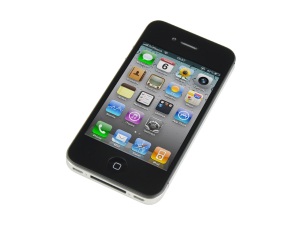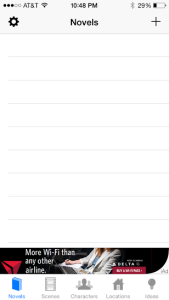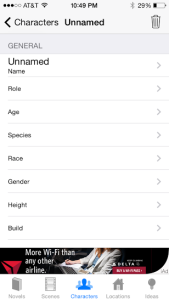Carly Norman:
J.D. Bolter once stated, “…we seem more impressed by the impermanence and changeability of text, and digital technology seems to reduce the distance between the author and reader by turning the reader into an author herself.” The purpose of Starvids is to do just that. Users create multi-genre mixed media to generate inspiration. You may sign up or log in with Facebook or Twitter.
Welcome to Starvids. Using the search bar, you can find posts to view. When searching, you will come across media from other Starvids users that have tagged the keyword in their post. In Michael Wesch’s YouTube video, “An Anthropological Introduction to YouTube,” he speaks of fame stemming from outlets of social media. We hope that this App will become a popular outlet of social media and recognition will derive from these searches.
The functions of the toolbar are Home, Categories, Friends and Me. Much like the writing app, Mindly, Starvids organizes creativity in a visual context. Mindly is used to spark inspiration using one’s own organized ideas and Starvids can do the same by being a provider of inspiration for writing. Inspiration can stem from your own posts or other’s.
In the Friends tab, you may click the connected tab to see whom you are already friends with; you can click connecting to see pending requests. You may also connect with your Facebook, Twitter or Instagram account. In relation to DeVoss and Porter’s article, “Why Napster matters to writing…”, this option gives you the liberty to chose who you are sharing ideas with. The sharing is consensual; you decide who can view your files or posts.
When you click the collaborate circle on the home screen, you will be able to create media in collaboration with another user. You will be prompted to type in the other user’s name and once they accept your offer to collaborate, you will be connected. The format is much like a google.doc in which both members can work simultaneously. There is also a chat screen provided at the bottom of the page.
Liz Romeo:
The “create” button of the app opens into a screen that allows the users to decide whether to take a picture or a video. As Kevin Kelly points out, we are creatures of the screen, and “cheap digital creation tools have empowered a new generation of filmmakers.” Our app allows people to create their own sort of entertainment in the form of films and images with new and innovative features that other apps do not have.
If the user chooses to create a picture, the app opens into a camera screen in which the user has the option to either select an image from their camera roll, or to take a new photo. StarVids was created in light of the dynamic and shared nature of the Web 2.0, and so users are able to share their own images and use already shared images.
The next page of the app offers the user a variety of filters that they can add to their image. At this point, as well as all points in the creation process, StarVids allows users to save their work to go back to later. Like the app “A Novel Idea,” this lets users express their creativity whenever ideas strike.
Users then have the option to add a sound effect to their image. These effects add another dimension to the image that most apps do not, and include sounds like thunder, applause, and more. As DeVoss and Porter point out, “people do not make new works out of nothing. They borrow…and massage fragments into new works.” Our app acknowledges this fact, allowing users to piece together a work in various steps.
The final option for editing images allows the users to add words to their image. Like Bolter discusses in regards to the remediation of print, writing is no longer simply about the text; rather, the most successful writing of today and the future will incorporate traditional methods of writing with images and/or sound, which our app allows users to do. StarVids isn’t just about sharing pictures on social media; it’s about creating art of the future in the form of writing, images, and sound.
Crystal Yeung
If the user chose the video button it will take the user to the video page which is similar to the picture section. Here they are allowed to take a video or choose a previously taken video from the computer. According to Bolter remediation is when new technology replace previous technology.
The next page is the filter page where you can add filters to your video and it lets users use their creativity and make the video their own. According to Anthropological Introduction to YouTube there are 9323 hours of video being uploaded a day.
The following page of the app will allow user crop their videos and take our parts that they dont want in the video.. After that is the audio page where they can add audio into the video which includes applause, claps,boos etc.
The last page is the text page where users can add words to their videos. Her you can add different style of text to your video and this like previously mention will help students writing.
Kyle Hamilton:
The sharing feature of Starvids is perhaps one of the most vital functions of the app because without being able to share what you’ve created then it just sits there on your smartphone making no difference to the world. This app offers 5 outlets for sharing the public options are Facebook, Twitter, and Youtube. If you want to share your video privately you can do so via either text messaging the video or attaching the video to an e-mail.
When looking at the app In terms of remediation which is covered by Bolter, the sharing function of this app remediates sharing by offering both public and private access to this media whereas most sharing options on other apps mostly allow for only public sharing.
DeVoss and Porter speak on many issues regarding Napster and file sharing. The biggest issue would have to be about copyright and ownership. Once again though our app allows protection so that if you want your Starvid to be public you would post it to Facebook, Twitter, or Youtube and if you want it to be private you can send it via text, e-mail, or you can choose to keep the Starvid on your phone.
In Michael Wesch’s anthropological introduction to YouTube he showed how one person from New Jersey changed Youtube forever when he recorded himself doing what later came to be known as the “Numa Numa Dance”. We still find ourselves to this day affected by this video as we continue to feel the need to produce videos of ourselves set to various different styles of music. The sharing feature of Starvids and any other app exist today because of the trend set by that one guy from Jersey.
Michael Fotos:
Users have the ability to explore content created by fellow users. You may use the search bar if you have a specific user or tag you are interested in viewing. Users also have access to the latest and most watched videos in given categories. These help define your interest and what Sherry Turkle calls one’s online persona.
All videos have listed the videographer, the number of views, favorites and the title associated with the piece. Below the video you will find an about section detailing the importance or purpose of the video as well as any extra information or plugs used to network and support an artist’s work. Users also may view comments with the name of the respected commenter’s username and a list of tags. This form of networking and commenting remediates the medium of video or movie review in magazines.
Profiles are used to share a user’s persona by providing a profile picture and name. Users with profiles have access to visual design settings to further individualize themselves.
To add, file sharing as discussed by DeVoss and Porter must be protected, so users have options to set their artwork as public, private (among a group of select users) or saved in which only the artists will be able to view the piece.
Creating a portfolio of work will provide a showcase of your creativity and individuality to the world and connect you with other personae that help prompt additional work, strengthen skills and network.
StarVids



 Often times, my family will discuss a particularly funny joke or play on words in spanish. There have been times when discussing these comical word choices in front of non-spanish speaking individuals in which we are asked for clarification. When translated, the joke is lost. Now, spanish won’t be going anywhere for quite some time, but when it is extinct, so is the joke, as well as the beautiful poems, the romantic ways to describe architecture and the intoxicating sound of a rolling “ere”.
Often times, my family will discuss a particularly funny joke or play on words in spanish. There have been times when discussing these comical word choices in front of non-spanish speaking individuals in which we are asked for clarification. When translated, the joke is lost. Now, spanish won’t be going anywhere for quite some time, but when it is extinct, so is the joke, as well as the beautiful poems, the romantic ways to describe architecture and the intoxicating sound of a rolling “ere”.




